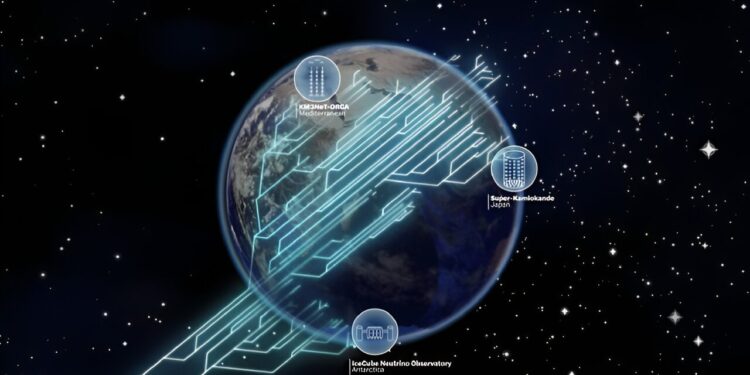Illustration of this analysis. The locations of the experiments used in this work are indicated. Note that Hyper-Kamiokande has roughly the same location as Super-Kamiokande. Credit: Physical examination (2023). DOI: 10.1103/PhysRevX.13.041055
A group of physicists, three from the Department of Physics and the Laboratory for Particle Physics and Cosmology at Harvard University, and the fourth from the University of Liverpool, have found evidence suggesting that additional measurements of neutrinos generated in the Earth’s atmosphere could be used to reveal how the three types of neutrino masses are ordered.
In their article published in the journal Physical examinationCA Argüelles, I. Martínez-Soler, M. Jin and P Fernández, describe how they conducted an analysis of the expected sensitivities of current and future atmospheric water/ice-Cherenkov neutrino experiments, as they may be related to the three types of neutrino oscillations.
Josh Spitz, a physicist at the University of Michigan, published a News & Views article in Nature describing the work the team has done on this new effort.
Neutrinos are subatomic particles and there are three known varieties; electron neutrino, muon neutrino and tau neutrino: its type is believed to be defined when it is created. Neutrinos can be created in a variety of ways, such as during a supernova or other major astral event. Interestingly, they can also change from one type to another, for example when crossing a planet. Such a change is known as quantum mixing.
Scientists study neutrinos in hopes of solving some of the great remaining mysteries in physics, such as the nature of gravity and dark matter. As the team leading this new effort notes, developing ways to measure neutrinos more precisely would provide a better understanding of how the mixture works. One of the goals is to determine the masses of the three types of neutrinos.
Physicists study neutrinos in a variety of ways, such as generating them using particle accelerators, observing them in nature, and studying the means by which they are generated in Earth’s atmosphere when cosmic rays enter colliding with atmospheric atoms. It is on this third method that the research team focused its efforts.
Current efforts to study these neutrinos typically involve building water or ice chambers with photodetectors sensitive enough to capture the neutrinos as they collide with atoms in the reservoir. By studying the light pattern emitted during such collisions, researchers can determine the type of neutrino involved, its energy level, and the distance it traveled before the collision.
By analyzing a large sample of these collisions and the data they have revealed so far, the research team found that the information is accumulating at a rate that should make it possible to determine the masses of the three types of neutrinos. by 2030.
More information:
CA Argüelles et al, Measuring oscillations with a million atmospheric neutrinos, Physical examination (2023). DOI: 10.1103/PhysRevX.13.041055
Josh Spitz, the secrets of neutrinos could be revealed by the Earth’s atmosphere, Nature (2023). www.nature.com/articles/d41586-023-04085-0
© 2023 Science X Network
Quote: The order of neutrino masses can be revealed by measuring those produced in the Earth’s atmosphere (December 27, 2023) retrieved December 27, 2023 from
This document is subject to copyright. Apart from fair use for private study or research purposes, no part may be reproduced without written permission. The content is provided for information only.



